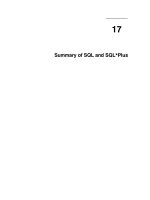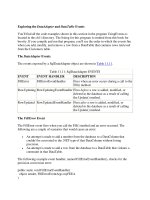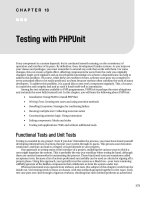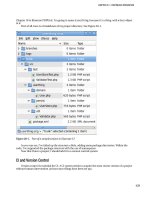Tài liệu Differences Between ADO and ADO.NET docx
Bạn đang xem bản rút gọn của tài liệu. Xem và tải ngay bản đầy đủ của tài liệu tại đây (16.4 KB, 1 trang )
Differences Between ADO and ADO.NET
ADO and ADO.NET are different in several ways:
•
ADO works with connected data. This means that when you access data, such as
viewing and updating data, it is real-time, with a connection being used all the
time. This is barring, of course, you programming special routines to pull all your
data into temporary tables.
ADO.NET uses data in a disconnected fashion. When you access data, ADO.NET
makes a copy of the data using XML. ADO.NET only holds the connection open
long enough to either pull down the data or to make any requested updates. This
makes ADO.NET efficient to use for Web applications. It's also decent for desktop
applications.
•
ADO has one main object that is used to reference data, called the Recordset
object. This object basically gives you a single table view of your data, although
you can join tables to create a new set of records. With ADO.NET, you have
various objects that allow you to access data in various ways. The DataSet object
will actually allow you to store the relational model of your database. This allows
you to pull up customers and their orders, accessing/updating the data in each
related table individually.
•
ADO allows you to create client-side cursors only, whereas ADO.NET gives you
the choice of either using client-side or server-side cursors. In ADO.NET, classes
actually handle the work of cursors. This allows the developer to decide which is
best. For Internet development, this is crucial in creating efficient applications.
•
Whereas ADO allows you to persist records in XML format, ADO.NET allows
you to manipulate your data using XML as the primary means. This is nice when
you are working with other business applications and also helps when you are
working with firewalls because data is passed as HTML and XML.









